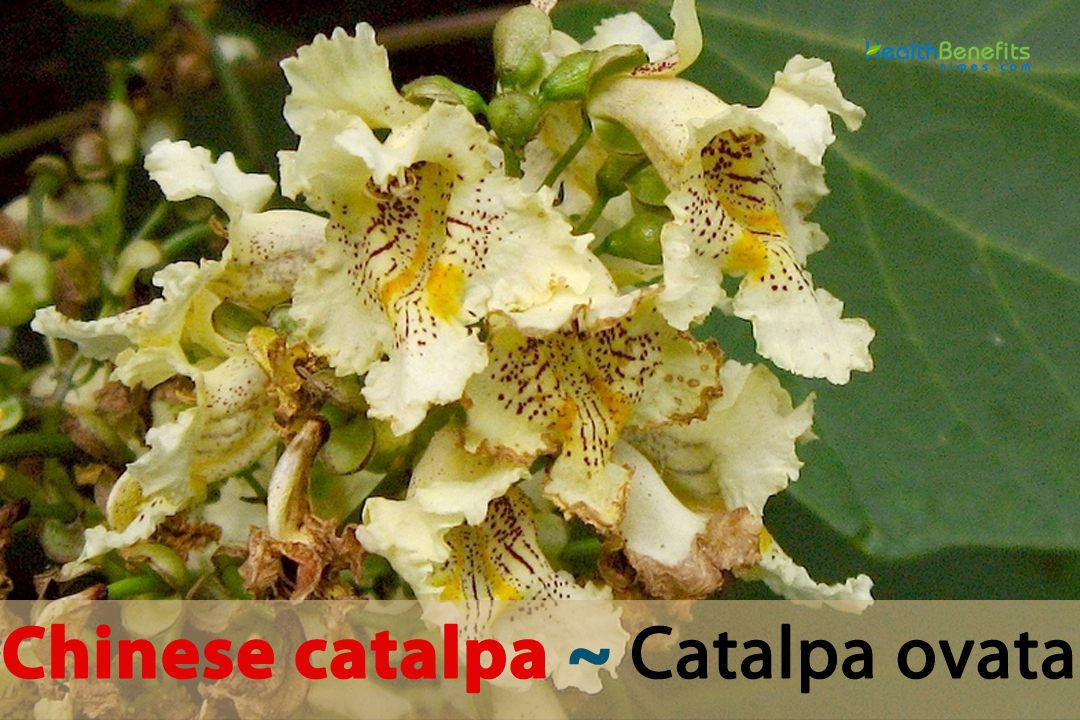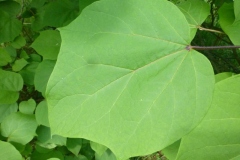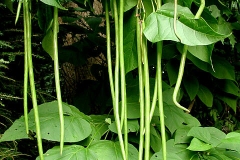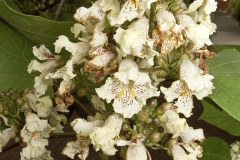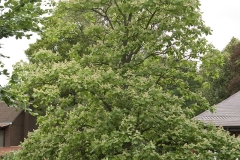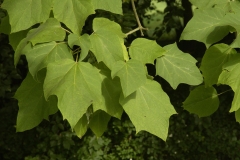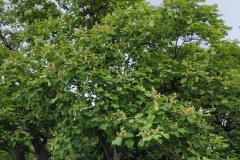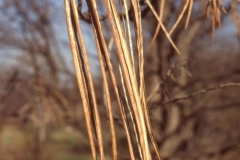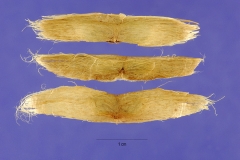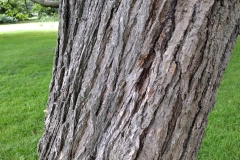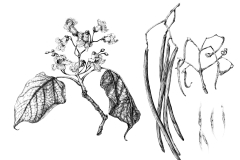| Chinese catalpa Quick Facts | |
|---|---|
| Name: | Chinese catalpa |
| Scientific Name: | Catalpa ovata |
| Origin | More temperate provinces within China and other parts of East Asia |
| Colors | Initially green turning to brown or dark brown color |
| Shapes | Long, cylindrical seed pods that resemble cigars, about 8 to 15 inches (20 to 38 cm) long |
| Taste | Mild citrus notes, with a hint of sweetness |
| Major nutrients | • Carbohydrate • Fiber • Phytochemicals • Minerals • Water • Proteins and Amino Acids • Lipids • Vitamins |
| Health benefits | Liver Health, Digestive Support, Skin Conditions, Respiratory Health, Used for Snakebites, Cardiovascular Health, Wound Healing, Bone Health, Gastrointestinal Health, Pain Relief, Weight Management |
| Name | Chinese catalpa |
|---|---|
| Scientific Name | Catalpa ovata |
| Native | More temperate provinces within China and other parts of East Asia. It is also cultivated in North America and Europe |
| Common Names | Chinese Catalpa, Chinese Bean Tree, Chinese Trumpet Tree, Manchurian Catalpa, Yellow Catalpa, Northern Catalpa, Indian Bean Tree, Hardy Catalpa, Orchid Catalpa, Yellow Trumpet Tree, Handkerchief Tree, Hardy Bean Tree, Mandarin Catalpa, Tung Oil Tree, Chinese Bignonia, Manchurian Trumpet Vine, Catalpa Fargesii, Chinese Northern Catalpa |
| Name in Other Languages | Afrikaans: Chinese katelpa Albanian: Katalpa kineze Arabic: Alkatalba Assiniya (الكاتالبا الصينية), Qutbi al-Siniya (قطبي الصينية), kitabat baydawia (كتلبة بيضوية) Armenian: Katalpa dzvadzev (Կատալպա ձվաձև) Assamese: Chainij Kyāṭālapā (চাইনিজ ক্যাটালপা) Azerbaijani: Çin katalpası, Yumurtavari katalpa Basque: Txinatar katalpa Belarusian: Kitayskaya katal’pa (Кітайская катальпа) Bengali: Chainija Kyatalapa Gachha (চাইনিজ ক্যাটালপা গাছ), Chainij Kyatalpa (চাইনিজ ক্যাটালপা) Bodo: Chaini Kaitalpa (चैनी कैटल्पा) Bosnian: Kineska katalpa Bulgarian: Kitayska catalpa (Китайска каталпа), yaĭtsevilna katalpa (яйцевилна каталпа) Chichewa: Katalpa ya China Chinese: Qinpi Zi (秦皮梓), Zǐ Shù (梓树), Shù Yīng Huā (树莺花), (Qiān Qū Cài (千屈菜), Huang hua qiu, Huo qiu, Zi shu, Azusa Kanō (梓叶), Shihakuhi (梓白皮) Croatian: Kineska katalpa Czech: Čínská catalpa, katalpa vejčitá Danish: Kinesisk catalpa, Trompetkrone Dogri: Chaini Kaitalpa (चाइनी कैटल्पा) Dutch: Chinese trompetboom, gele trompetboom English: Chinese Catalpa, Yellow Catalpa, Japanese Catalpa, yellow bean tree, Chinese catawbatree Esperanto: Ĉina katalpo Estonian: Hiina katalpa Filipino: Katalpang Intsik Finnish: Kiinan catalpa, Kiinantrumpettipuu, Keltatrumpettipuu French: Catalpa de Chine, Catalpa jaune, Catalpa de Chine, catalpa du Japon Garhwali: Chaini Kaitalpa (चाइनी कैटल्पा) Georgian: Chinuri k’atalp’a (ჩინური კატალპა) German: Chinesische Trompetenbaum, Kleinblütiger Trompetenbaum, gelber Trompetenbaum, japanischer Trompetenbaum, rundblättriger Trompetenbaum Greek: Kinezikí catalpa (Κινεζική καταλπα) Gujarati: Chāinī Keṭalpā (ચાઇની કેટલ્પા) Haitian Creole: Katalpa Chinwa Hausa: Katalpa Sin Hawaiian: Kākalupa Kina Hebrew: Katalpa Sinít (קטלפה סינית) Hindi: Chainīz Kaiṭalapā Vṛkṣa (चाइनीज कैटलपा वृक्ष), Chīnī Katlpā (चीनी कटल्पा), Chīnī Kaitalpa (चीनी कैटल्पा) Hmong: Chinese catalpa, Lus tsheej catalpa, Hmoob Txheej catalpa Hungarian: Kínai katalpa Icelandic: Kínversk katalpa Igbo: Katalpa Ndị Chayina Indonesian: Katalpa Cina, Pohon Catalpa Tiongkok Irish: Catalpa Síneach Italian: Catalpa cinese, Bignonia catalpa, Catalpa della Cina Japanese: Kiri (キリ), Chainīzu Kyatarupa (チャイニーズキャタルパ), Kiri Hanagamazu (キリハナガマズ), Ki sasage (キササゲ ) Javanese: Katalpa Cina Kannada: Chainīs kaṭālp (ಚೈನೀಸ್ ಕಟಾಲ್ಪ), Cīniya Kyāṭalpā (ಚೀನಿಯ ಕ್ಯಾಟಲ್ಪಾ) Kashmiri: Chīnī Kaitlap (چینی کیٹلپ) Kazakh: Shyn qatalpasy (Шын қаталпасы) Khasi: Chaini Kaitalpa (चाइनी कैटल्पा) Konkani: Chāynīs Kaṭalpā (चायनीस कॅटल्पा) Korean: Jungguk-gye mugunghwa namu (중국계 무궁화나무), Katalpa namu (카탈파나무), Jungguk Daewang Namu (중국대왕나무), Gae o dong na mu, gaeodong (개오동) Kurdish: Katalpa Çînî Kyrgyz: Chyn katalpasy (Чын каталпасы) Lao: Phom kha danin (ພົ້ມຂາດນີນ) Latvian: Ķīnas katalpa Lithuanian: Kininė katalpa Luxembourgish: Chinesesch Katalpa Macedonian: Kineska catalpa (Кинеска каталпа) Maithili: Chāinij Kyāṭalpā (चाइनिज क्याटल्पा) Malay: Katalpa Cina Malagasy: Katalpa Sinoa Malayalam: Chainīs kāṟṟālpa (ചൈനീസ് കാറ്റാല്പ) Maltese: Katalpa Ċiniża Manipuri: Chīnī Kyāṭālapā (চীনী ক্যাটালপা) Maori: Katalpa Hainamana Marathi: Chīnī Kaṭalpā (चीनी कॅटल्पा) Mongolian: Khyatadyn katalp (Хятадын каталп) Nepali: Chiniyān Kyāṭalpā (चिनियाँ क्याटल्पा) Norwegian: Kinesisk catalpa, Kinatrompettre Odia: Chaini Kaṭālapā (ଚାଇନି କଟାଲପା) Pashto: Chīnay catalpa (چیني کاتالپا) Polish: Katalpa chińska, katalpa żołtokwiatowa, surmia żołtokwiatowa Portuguese: Catalpa chinesa Punjabi: Chainī kīṭalpā (چینی کیٹلپا), Chīnī Kaitalpā (ਚੀਨੀ ਕੈਟਲਪਾ) Romanian: Catalpa chineză Russian: Kitayskiy katal’pa (Китайский катальпа), Katal’pa Kempfera, katal’pa yaĭtsevidnaya (катальпа яйцевидная) Samoan: Katalpa Saina Santali: Chāinī Kaṭālapā (चाइनी कटालपा) Serbian: Kineska katalpa (Кинеска каталпа), istočnoazijska katalpa (источноазијска каталпа) Sesotho: Katalpa ea Tsaina Shona: Katalpa yeChina Sindhi: Chaini Kaitalpa (چائني ڪيٽلپا) Somali: Katalpa Shiinaha Sinhala: Chīna kæṭalpa (චීන කැටල්ප) Slovak: Čínska katalpa Slovenian: Kitajska katalpa Spanish: Catalpa china, catalpa amarilla Sundanese: Katalpa Cina Swahili: Katalpa ya China Swedish: Kinesisk katalpa Thai: Ton kāefe chīn (ต้นกาแฟจีน), Ton Khāthālpā Jīn (ต้นคาทาลปาจีน) Tajik: Kitoi catalpa (Китои каталпа) Tamil: Cīṉa kāṭālpā (சீன காடால்பா) Telugu: Cainīs kāṭalpa (చైనీస్ కాటల్ప) Turkish: Çin katalpa ağacı Turkmen: Çin katalpası Ukrainian: Kytays’ka katal’pa (Китайська катальпа), katalʹpa bihnoniyevydna (катальпа бігнонієвидна) Urdu: Cheeni Katalpa Darakht (چینی کیٹالپا درخت), Chīnī Kaitalpā (چینی کیٹالپا) Uzbek: Xitoy katalpasi Vietnamese: Cây chuồn chuồn Trung Quốc, Cây Cẩm tú cầu Trung Quốc Welsh: Catalpa Tsieineaidd Xhosa: I-Katalpa yaseChina Yiddish: Tsinazish catalpa (טשינעזיש קאַטאַלפּאַ) Yoruba: Katalpa Saina Zulu: I-Katalpa yaseChina |
| Plant Growth Habit | Small, fast growing, medium sized deciduous pod-bearing tree |
| Growing Climates | Open country and margins of woods |
| Soil | Prefers well-draining soil that is slightly acidic to neutral. While it can tolerate a range of soil types, it performs best in rich, moist soils |
| Plant Size | 20 to 40 feet (6 to 12 meters) with a spread of around 15 to 30 feet (4.5 to 9 meters) |
| Root | Typically develops a taproot, which is a primary, central root that grows vertically into the soil. Lateral roots are secondary roots that branch out horizontally from the taproot and extend into the surrounding soil |
| Bark | Bark of young trees is generally smoother and lighter in color, often with a slightly striped or patterned appearance. As the tree matures, the bark becomes rougher, darker, and more textured |
| Leaf | Leaves are in an alternate, sometimes whorled, arrangement. They are wide and ovate in shape that is usually entire but sometimes can have 3 to 5 lobes. The leaves are light green turning yellow in the fall. |
| Flowering season | May to June |
| Flower | Tree produces clusters of fragrant, white flowers with yellow or purple markings. These trumpet-shaped flowers are about 1 inch in diameter and are borne in terminal panicles |
| Fruit Shape & Size | Long, cylindrical seed pods that resemble cigars, about 8 to 15 inches (20 to 38 cm) long |
| Fruit Color | Initially green turning to brown or dark brown color as they ripen |
| Seed | Seeds are flat and have a broadly elliptical or ovate shape about 0.2 to 0.4 inches (5 to 10 mm) in length and width |
| Flavor/Aroma | Unique blend of sweet and earthy notes |
| Taste | Mild citrus notes, with a hint of sweetness and a slightly bitter undertone |
| Plant Parts Used | Bark, leaves, roots, fruits, flowers |
| Propagation | By Seed, semi-hardwood or hardwood cuttings, Layering, Grafting, Air Layering |
| Lifespan | Around 30 to 50 years in their natural habitat |
| Season | September to October |
| Varieties |
|
| Major Nutrition |
|
| Health benefits |
|
| Available Forms |
|
Plant Description
Chinese catalpa is a small to medium-sized tree that grows quickly and has pods. It is a deciduous tree that usually grows between 20 and 40 feet (6 to 12 meters) tall and spreads out between 15 and 30 feet (4.5 to 9 meters). The plant grows in open land and on the edges of woods. The plant does best in soil that drains well and is slightly acidic to neutral in ph. Even though it can grow in many kinds of soil, it does best in rich, wet soil. Chinese catalpa trees can be used in schools to teach children about plant biology, ecology, and the role trees play in the environment. The wood of the Chinese catalpa is light and strong enough to be used to make things like singing instruments, tool handles, and decorative carvings. It is picked from the wild and used as food and medicine in the area.
Appropriate growing environments for Chinese catalpa
The Chinese catalpa is a deciduous tree that is native to China and has become popular in various parts of the world as an ornamental tree. Here are some appropriate growing environments and care tips:
- Climate: Chinese catalpa grows well in temperatures that range from temperate to subtropical. Most of the time, it can survive in USDA hardiness zones 5 to 9. It can handle some cold, but in very hard winters, it might have trouble.
- Sunlight: This tree does best in full sun rather than in part shade. For best growth and blooming, plant it in a spot where it will get at least 6 hours of direct sunshine every day.
- Soil: Chinese catalpa likes soil that drains well and is slightly acidic or neutral. It can grow in many kinds of soil, but it likes rich, wet soil best. Adding organic matter to the soil can help it grow more plants and drain better.
- Watering: Even though Chinese catalpa can handle drought once it’s established, it does best with regular feeding, especially when it’s first getting started. Make sure the dirt is always moist, but not so wet that it can’t be worked.
- Spacing: When you plant Chinese catalpa trees, give them enough room to grow to their full size without crowding them. Most of the time, you should leave 20 to 30 feet between trees.
- Pruning: During the tree’s inactive season, prune it to get rid of any dead or sick branches and shape it if you need to. This can also help the air move better through the roof.
- Fertilization: Fertilizing Chinese catalpa trees every once in a while helps them grow and bloom well. In the spring, use a regulated fertilizer that releases nutrients slowly.
- Mulching: Put a layer of organic mulch around the tree’s base to help keep the soil wet, keep weeds from growing, and make the soil better. To keep the tree from rotting, keep the mulch a few inches away from the root.
- Pest and Disease Management: Most bugs and diseases don’t bother Chinese catalpa trees very much. But it’s a good idea to keep an eye out for signs of trouble, like discolored leaves, wilting, or bugs, and take the right steps if needed.
- Landscape Use: Because its flowers are so pretty, Chinese catalpa can be used as a shade tree, an ornamental plant, or even to bring in bees. If you have a small yard, think about how big it will get.
Roots
When the Chinese catalpa is young, it usually gets a taproot, which is a main root that grows straight down into the soil. The taproot helps the tree stay in place and protects it from wind and other forces. Lateral roots are secondary roots that grow out from the taproot in a horizontal direction and into the dirt around them. These roots are very important for getting water and food from the dirt. As a Chinese catalpa gets larger, its roots change into a structure with more fibers. This means that the root system grows more branches, and many small roots grow from the side roots. Most of the time, the root system doesn’t go very deep into the dirt. Instead, it spreads out more than it goes down. The lateral roots can grow a long way from the tree’s base, often covering more ground than the tree’s crown.
Stem
The tree’s trunk is the main straight stem that holds it all up. It grows from the ground up and divides into smaller roots and branches as it goes. The root gives the tree its shape, carries water and nutrients, and allows photosynthates, which are made in the leaves, to move to other parts of the tree. As the tree grows, the base sends out many side branches that reach out and up. Most of the branches are open and low, giving the tree a round head.
Lenticels are tiny, raised holes on the surface of the stem. They make it easier for gases to move between the inside of the stem and the outside world. Specialized vascular bundles in the stem are in charge of moving water, minerals, and nutrients from the base to the leaves. Xylem vessels carry water and minerals from the roots to the rest of the plant. Phloem cells carry sugars and other results of photosynthesis from the leaves to the rest of the tree. Nodes are the places on a stem where leaves, branches, or other parts are connected. The parts of the stem between the nodes are called internodes. Nodes are very important to the growth and development of a tree because they are where new growth starts, like leaves and side branches.
Bark
Young trees tend to have bark that is smoother and lighter in color, and it often has a striped or patterned look. The bark gets rougher, darker, and more detailed as the tree gets older. The color of the bark on a grown tree can range from grayish-brown to darker shades of brown, which adds to its beauty. The cork cells make up the periderm, which is the top layer of bark. At full size, these cork cells are dead and are tightly packed together to make a barrier. The corky layer helps keep germs out and keeps water in. Over time, patches of the older periderm layers may peel off, showing the newer layers underneath.
As the tree gets older, its bark gets cracks, furrows, and ridges that don’t line up. The tree’s stem and branches have grown and spread out to make these natural shapes. These cracks can be homes for insects and birds, which makes the tree even more important to the environment. The bark can have different textures because of how the cork cells are arranged, how fast they grow, and how the world affects them. The tree looks better because it has a mix of smooth, rough, and uneven surfaces.
Leaves
The leaves are arranged in an opposite pattern, which means that each pair of leaves along the stem is exactly opposite the other pair. Because of this, the leaves line up in a perfect pattern along the branches. The leaves are basically egg-shaped, with a wide base and a pointy tip. The leaf’s edge is serrated or “toothed,” which makes the leaf look a little bit sharp. The size of leaves can change, but most of the time they are between medium and large. The mature leaves can be anywhere from 6 to 12 inches (15 to 30 cm) long and 3 to 6 inches (8 to 15 cm) wide.
The veins on a leaf are easy to see, and they spread out from the midrib. These lines help water, food, and sugars get to all parts of the leaf. The leaves of a Chinese catalpa change color as the seasons go by. During the spring and summer, the leaves are a bright green color, which gives the tree its typical lush look. In the fall, the leaves turn a beautiful yellow or gold color before falling off the tree. The top side of the leaves is smooth and shiny, while the bottom side is a lighter shade of green and not as shiny. This difference in structure helps the leaf take in more light and keeps less water from escaping through the stomata on the lower leaf surface.
Stomata are small holes that are mostly on the bottom of a leaf. They let gases move in and out, so carbon dioxide can get into the leaf for photosynthesis and oxygen and water vapor can get out. Each leaf’s base tapers into a stalk-like part called the petiole, which connects the leaf to the stem. The petiole makes it possible for the leaf to face the sun in the best way. Chinese catalpa leaves are pinnate, which means that the main veins start at the midrib and branch out like the veins of a wing. This design helps water and nutrients get to every part of the leaf.
Flowers
The plant makes what are called “perfect” flowers, which are those that have both male and female sexual parts in the same flower. The flowers are grouped together in big groups called inflorescences. These groups of flowers are usually at the ends of stems and can have more than one flower in them. Flowers have a trumpet-like shape, like a swollen tube. The tube of the flower gets wider as it gets closer to the opening and then gets narrower as it goes down. The size of each flower can be different, but they are usually big and showy. The trumpet-shaped flowers can be anywhere from 2.5 to 5 cm (about 1 to 2 inches) across. Most of the time, the flowers are white or a light cream color, which makes them look nice and draws pollinators.
The corolla is the group of petals that give the flower its characteristic trumpet shape. Most flowers have five lobes on their petals that spread out at the trumpet’s opening. The parts of a flower that make male offspring are called stamens. They are made up of long strands that end in anthers. The pollen, which is made by the anthers, includes the male gametes that are needed for fertilization. The pistil is the female part of the flower that makes seeds. It has three main parts, which are the stigma, the style, and the ovary. The stigma is the part of the pistil at the top that lets sperm in. The style is the thin line that goes from the stigma to the ovary. Ovules, which could become seeds, are found in the ovary. Flowers can pollinate and feed themselves without needing pollen from another tree. Cross-pollination by pollinators, such as bees and butterflies, can still happen and increase genetic variety. Some flowers have a sweet smell that draws pollinators like bees and butterflies.
Fruits
The tree makes fruits that are long and spherical. These fruits are often called “pods” or “capsules.” Most of the time, the fruits grow in groups at the ends of branches, which is often where the flowers used to be. The fruit shells look like skinny bean pods because they are long and cylindrical. They come in different sizes, but most are between 8 and 15 inches (20 to 38 cm) long. At first, the fruit pods are green, but as they ripen, they turn brown or dark brown. When the fruit pods are fully grown, the outside becomes hard and woody. This protects the seeds inside. Chinese catalpa has fruit pods that are dehiscent, which means they split open along seams or lines to let the seeds out. This split makes it possible for seeds to spread out into the surroundings.
Seeds
The seeds are flat and have a shape that is either circular or ovate. In one way, they are bigger than in the other. The seeds can be different sizes, but most of them are small, about 0.2 to 0.4 inches (5 to 10 mm) long and wide. Most of the time, the seeds are light brown or tan. The color may be a little different based on things like how old the plant is and how the environment is. The seed coat, also called the testa, is the thin layer on the outside of the seed that protects the baby inside. One thing that makes seeds stand out is that they have membrane-like wings connected to one side. These wings are flat, thin extensions that make it easy for the wind to carry the seeds. The embryo, which is the young, not-fully-grown plant, is inside the seed coat. The embryo is made up of the plumule (the embryonic shoot), the radicle (the embryonic root), and the cotyledons.
Varieties of Chinese catalpa
The Chinese catalpa has several recognized varieties that exhibit different characteristics or variations in their growth habits, leaves, flowers, or other features. While not an exhaustive list, here are a few notable varieties of the Chinese catalpa:
- Catalpa ovata var. ovata: This is the most common type, and it grows naturally in China and other parts of East Asia. It has the usual features, like broad, ovate leaves, white flowers that look like trumpets, and long fruit capsules.
- Catalpa ovata var. inermis: This type is also called the “Chinese Catalpa Variety without Thorns” because its branches don’t have thorns. It is similar to the standard version in most ways, but it is prized for growing without thorns.
- Catalpa ovata ‘Nana’: This type of Chinese catalpa is small and close to the ground. It is grown because it stays small, which makes it good for small gardens or landscapes with limited room. Many of the species’ typical traits are still present in “Nana,” but they are on a smaller size.
- Catalpa ovata ‘Aurea’: This type is known for its leaves that are golden or yellow. The golden color of the leaves makes the tree look different from other trees. When placed next to other trees with green leaves, the ‘Aurea’ variety makes a nice contrast.
- Catalpa ovata ‘Purpurea’: The ‘Purpurea’ type is known for its leaves that are purple or reddish. The leaves are a deep red or purple color, which makes them stand out against the green leaves of other trees.
- Catalpa ovata ‘Albatross’: This type is liked because its flowers are bigger than average. The flowers are even more beautiful than those of a typical Chinese catalpa because they are bigger and have a trumpet shape.
- Catalpa ovata ‘Pygmaea’: The ‘Pygmaea’ variety of the Chinese catalpa is a small form that looks a lot like the ‘Nana’ variety. It is picked because it is small, so it can be grown in small gardens, in containers, or as a bonsai.
- Catalpa ovata ‘Aurea Maculata’: This type is known for its leaves that have different colors. The leaves are a mix of green and yellow, which gives them a unique look that is pleasing to the eye.
- Catalpa ovata ‘Flava’: The ‘Flava’ type stands out because its flowers are yellow instead of white. This change in color gives the tree’s flowers a lively touch.
- Catalpa ovata ‘Fastigiata’: This type stands out because it grows in a straight line. It has a narrow, compact shape that works well in cities or other places with limited room.
- Catalpa ovata ‘Pendula’: The ‘Pendula’ type of the Chinese catalpa is a weeping type. It looks beautiful and graceful because its branches hang down in a cascade.
- Catalpa ovata ‘Variegata’: This variety, like ‘Aurea Maculata,’ has leaves that are different colors. The irregular designs of green and white on the leaves make them stand out and look interesting.
- Catalpa ovata ‘Purple Catalpa’: This type is known for having leaves that are black. The leaves turn purple or burgundy, giving the scenery a touch of dramatic color.
- Catalpa ovata ‘Silver Cloud’: “Silver Cloud” is known for its leaves that have silvery-white stripes. The silvery color of the leaves gives them a unique, dreamlike look.
- Catalpa ovata ‘Spectacular’: This type lives up to its name with flowers that are bigger than average and a striking overall look. Compared to the standard variety, it has a more dramatic flower show.
- Catalpa ovata ‘Flame’: In the fall, “Flame” is known for its bright red and orange leaves. Before they fall, the leaves make a colorful show in the fall.
- Catalpa ovata ‘Golden Wattle’: This variety has leaves that stand out in the scenery because they are golden yellow. The color of the leaves stays the same all through the growing season.
- Catalpa ovata ‘Rubra’: The leaves of ‘Rubra’ are valuable because they are red or reddish-purple. The leaves turn bright shades of red, which makes the tree look more interesting.
Chinese catalpa Image Gallery
Health benefits of Chinese catalpa
Chinese catalpa is a deciduous tree native to China. While it is primarily known for its ornamental value due to its attractive flowers and foliage, it has also been associated with several potential health benefits. Here are some of the reported health benefits of Chinese catalpa:
1. Anti-Inflammatory Properties
Its anti-inflammatory qualities have been used for a long time. People think that some parts of the tree’s extracts have anti-inflammatory effects, which could help people with diseases that cause inflammation.
2. Antioxidant Activity
Some of the bioactive chemicals in Chinese catalpa, such as flavonoids and phenolic compounds, have antioxidant properties. Antioxidants help fight oxidative stress, which is linked to a number of long-term illnesses and getting older.
3. Liver Health
TCM has used leaves to help keep the liver healthy. People think that these leaves can help clean out the liver and make it work better.
4. Digestive Support
Some of the usual ways Chinese catalpa was used was to help with digestion. It has been used to ease stomach pain and keep the digestive system healthy.
5. Skin Conditions
People have put the leaves and bark on their skin to treat things like rashes, itching, and small cuts. Some of these benefits could come from the extracts’ possible anti-inflammatory and healing effects.
6. Respiratory Health
In Traditional Chinese Medicine (TCM), Chinese catalpa has been used to treat coughs and phlegm. People think that the leaves and flowers have qualities that can help clear up congestion and make it easier to breathe.
7. Used for Snakebites
Due to their possible anti-venom effects, Chinese catalpa leaves were sometimes used to treat snakebites in the past.
8. Anti-Cancer Properties
Some studies show that flavonoids and phenolic compounds, which are found in Chinese catalpa, may be able to fight cancer. It has been shown that these compounds have antioxidant and anti-inflammatory benefits, which are thought to help prevent and treat cancer.
9. Cardiovascular Health
Researchers have looked into how Chinese catalpa products might help the heart. Some of the tree’s chemicals, such as quercetin and rutin, have been linked to better heart health by lowering blood pressure, lowering cholesterol levels, and making blood vessels work better.
10. Antimicrobial Activity
Research shows that products of Chinese catalpa may be able to kill germs. Some parts have shown that they can stop bacteria and fungus from growing, which suggests that they could help keep the immune system healthy and fight infections.
11. Antiviral Potential
In early tests, some compounds have shown that they can kill viruses. Based on these results, it seems likely that the tree’s extracts could be used in antiviral treatments, but more study is needed to find out how well they work against specific viruses.
12. Anti-Diabetic Effects
Some of the chemicals in Chinese catalpa, like flavonoids, have been looked at to see if they could help control blood sugar levels and make insulin work better. People with type 2 diabetes or those who are at risk of getting it could benefit from these affects.
13. Neuro-protective Properties
Researchers have looked into how Chinese catalpa extracts might help the brain. Components like flavonoids and phenolic compounds have antioxidant properties that may help protect brain cells from oxidative stress and possibly lower the chance of neurodegenerative diseases.
14. Wound Healing
Traditionally, Chinese catalpa has been used to treat cuts and skin problems. Some study suggests that the tree’s extracts may help wounds heal because they may speed up the production of collagen and help the skin grow back.
15. Bone Health
Some of the chemicals in Chinese catalpa, like flavonoids and phenolic acids, have been looked at to see if they can help keep bones healthy. These substances might be able to improve bone mineral density and help with the health of the skeleton as a whole.
16. Anti-Allergic Properties
Chinese catalpa products have been looked at to see if they might help with allergies. Some of the tree’s chemicals, like quercetin, have been shown to stop the release of histamine and other compounds that cause inflammation. This could help ease allergic responses and symptoms.
17. Anti-Aging Effects
Bioactive compounds in Chinese catalpa, such as flavonoids and phenolic compounds may have anti-aging benefits because they are antioxidants. Antioxidants help fight reactive stress, which is one of the main causes of aging.
18. Gastrointestinal Health
Chinese catalpa helps the digestive system work well and relieves stomach pain. Tannins, which can be found in the tree’s leaves, may help with stomach problems and improve the health of the gut.
19. Pain Relief
Chinese catalpa has been used for pain relief for a long time because it may help reduce inflammation. These qualities might help ease the pain of conditions like arthritis and other inflammatory diseases.
20. Weight Management
Some chemicals, like flavonoids, have been linked to possibly helping people lose weight. These chemicals may help regulate the metabolism and control hunger.
21. Anti-anxiety Properties
Some studies show that some parts of Chinese catalpa might have anxiolytic effects, which would help to ease the symptoms of anxiety. It might have these effects because it can change the way chemicals work in the brain.
Culinary Uses of Chinese catalpa
Chinese catalpa is not commonly known for its culinary uses, and there is limited information available about its edibility. However, some parts of the tree have been used in traditional cuisines in certain regions for their potential flavor or nutritional value. Here are some reported culinary uses of Chinese catalpa:
- Edible Flowers: In some countries, the flowers have been used to decorate salads and other foods. These flowers can be used to add a bit of color and a light floral flavor to food.
- Tea: In traditional plant uses, Chinese catalpa leaves are steeped to make tea. People think that the tea has cooling qualities and a mild taste. It’s important to remember, though, that not all parts of the tree may be safe to eat.
- Fritters or Tempura: Some sites say that you can coat the flowers or young leaves in batter and fry them as fritters or tempura. This could be a way to add the plant to food to give it a different feel and taste.
- Pickled Buds: In some parts of the world, the young buds are pickled and used as a flavoring or relish. Buds that have been pickled can give food a sour and slightly bitter taste.
- Leaf Wraps: In traditional cooking, especially in some countries, the leaves were used to wrap food in a natural way. They could be used to wrap food before it is cooked or grilled, giving it a slight flavor.
- Flower Infusions: The flowers can also be put into liquids, like water or vinegar, to make drinks or sauces that taste like flowers.
- Herbal Soups: In some ancient ways of doing things, leaves or flowers were added to soups and broths to make them taste better and possibly help with health.
- Floral Flavors: People say that the flowers have a light floral scent. Some people who like to cook may try adding these flowers to desserts, syrups, or sauces to give them a unique flowery taste.
- Condiments and Sauces: Some parts of the Chinese catalpa tree have been used to make sauces, condiments, and vinaigrettes in some countries. There’s a chance that these preparations could add depth and variety to dishes.
- Fermentation: Parts of the Chinese catalpa tree, like the leaves or buds, are fermented in some traditional ways. Fermentation can be used to make new flavors or keep plant parts so they can be eaten later.
Different Uses of Chinese catalpa
The Chinese catalpa is a versatile plant that has various uses and benefits. Here are some of its different uses:
- Ornamental Plant: Because its leaves and flowers are so unique and pretty, Chinese catalpa is often grown as a decorative plant in gardens and parks. It has large, heart-shaped leaves and clusters of flowers that look like tubes, which make it a nice addition to outdoor areas.
- Shade Tree: The Chinese catalpa can grow into a big tree that gives a lot of shade in cities and neighborhoods. It is a popular tree to put in parks and along streets because its large leaves make a dense canopy that blocks the sun.
- Wildlife Habitat: Pollinators like bees and butterflies come to the tree’s flowers and leaves to do their work. Also, the seeds that the Chinese catalpa makes are a good food source for many birds and small mammals, which helps the local ecosystems of wildlife.
- Timber: Catalpa wood from China is used for many things, like making furniture, cabinets, and other woodworking projects. The wood is not too heavy and easy to work with, so it can be used for many different things.
- Erosion Control: The Chinese catalpa has a large root system that helps stabilize the soil and stop erosion. This makes it a good choice for planting on hills or in places where the soil tends to break down quickly.
- Beekeeping: T The Chinese catalpa’s flowers, which are full of nectar, draw bees, so it could be used by beekeepers to make honey.
- Fodder: In some places, the leaves of the Chinese catalpa are fed to livestock because they are a healthy form of food.
- Shelterbelt Planting: The Chinese catalpa can be used as a windbreak or shelterbelt plant because it grows quickly and has thick leaves. This helps stop wind erosion and protects crops or other plants.
- Educational Purposes: Chinese catalpa trees can be used in schools to teach children about plant biology, ecology, and the role trees play in the environment.
- Woodcraft: The light and fairly strong wood can be used to make things like singing instruments, handles for tools, and decorative carvings.
- Biofuel Production: In some places, trees grow quickly enough to be a possible source of biomass for making biofuels, which helps with efforts to use sustainable energy.
- Dye Source: The bark and leaves can be used to make natural dyes in dark and green shades. In the past, these colors were used to make clothes and other things.
- Landscaping: Trees can be planted in interesting ways to add visual interest to landscaping designs. They can be used as focal points and to improve the general look of outdoor spaces.
- Educational Research: Trees can be used as subjects for research projects in educational and scientific institutions that deal with plant biology, genetics, and the environment.
- Soil Improvement: The leaves can be used as organic mulch. As the leaves break down over time, they add nutrients to the soil.
- Traditional Crafts: Long seed pods that look like beans can be used to make traditional crafts like baskets and decorations.
- Insect Repellent: Some people have used extracts from the Chinese catalpa’s leaves or bark as natural bug repellents to keep pests out of their gardens or other outdoor areas.
- Aesthetic Woodwork: Chinese catalpa wood is a good choice for making art and decorations out of wood because of its unique grain pattern and color.
Side effects of Chinese catalpa
Certainly, here are the potential side effects associated with the Chinese catalpa (Catalpa ovata):
- Invasiveness: In places where it is not native, Chinese catalpa can grow quickly and crowd out native plants. This is bad for natural environments because it decreases biodiversity and changes the way habitats are built.
- Allergic Reactions: Some people may have allergic responses to the pollen, leaves, or other parts of the Chinese catalpa plant. There could be redness of the skin, rashes, and trouble breathing.
- Messy Seed Pods: When long seed pods fall to the ground, they can make a mess and leave trash in yards and public places. Also, the seeds may grow and cause growth that wasn’t planned.
- Root Issues: The large root system can make it hard for other plants to grow, which is called root competition. It could also hurt sidewalks, foundations, and equipment that is underground.
- Allelopathy: Chinese catalpa may give off chemicals that stop close plants from growing, making it hard for new plants to grow.
- Insect Infestations: Trees can be hurt by insects like caterpillars and borers, which can hurt their health and look.
- Disease Vulnerability: Like other plants, it can get sick, especially from fungal conditions that can make it less healthy.
- Ecological Disruption: Invasive Chinese catalpa can upset native environments, making it harder for local wildlife to get food and find a place to live.
References:
https://www.itis.gov/servlet/SingleRpt/SingleRpt?search_topic=TSN&search_value=34314#null
https://npgsweb.ars-grin.gov/gringlobal/taxon/taxonomydetail?id=9591
https://pfaf.org/user/Plant.aspx?LatinName=Catalpa+ovata
https://www.cabidigitallibrary.org/doi/10.1079/cabicompendium.16808
https://www.missouribotanicalgarden.org/PlantFinder/PlantFinderDetails.aspx?taxonid=277906
https://gd.eppo.int/taxon/CTLOV
https://en.wikipedia.org/wiki/Catalpa_ovata
https://temperate.theferns.info/plant/Catalpa+ovata
https://plants.usda.gov/home/plantProfile?symbol=CAOV5


